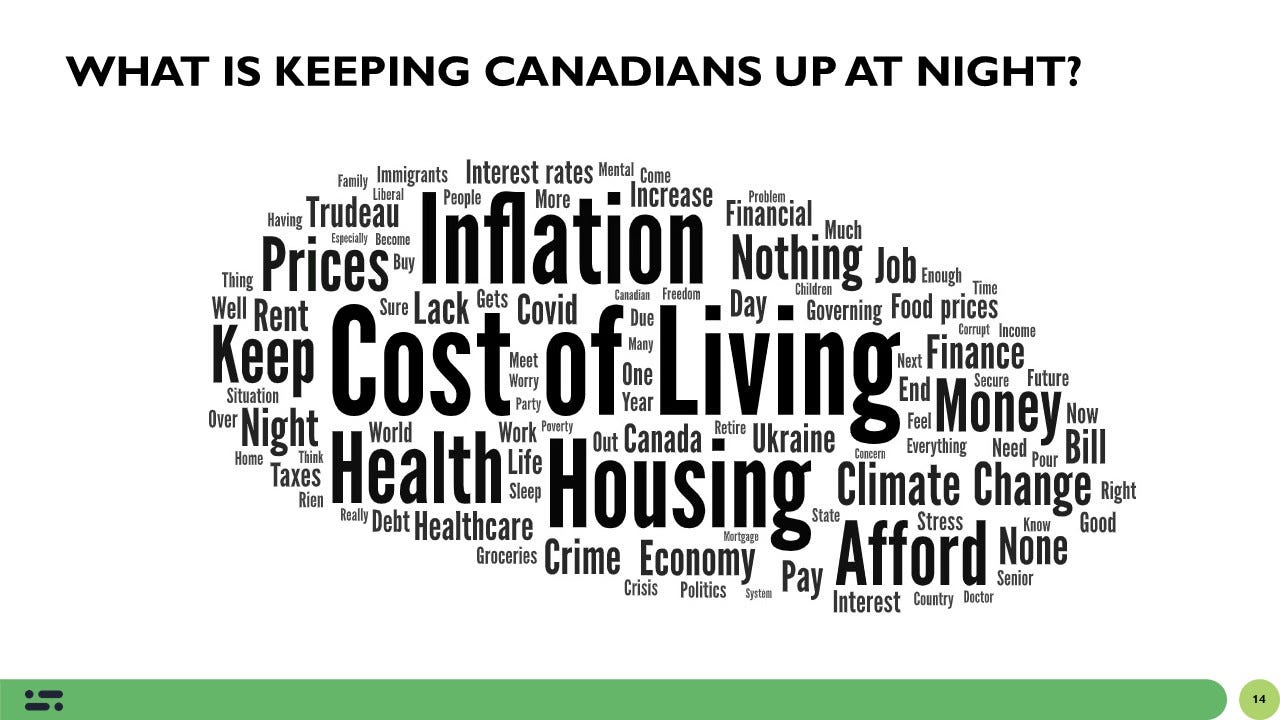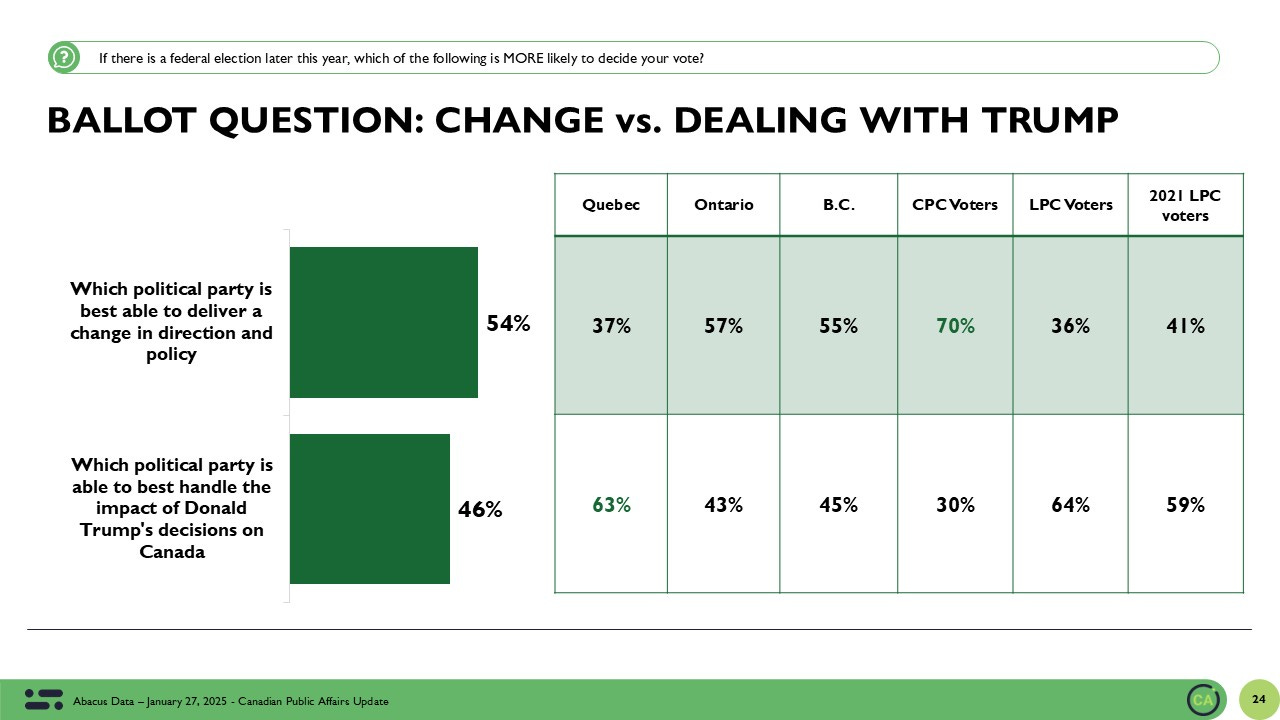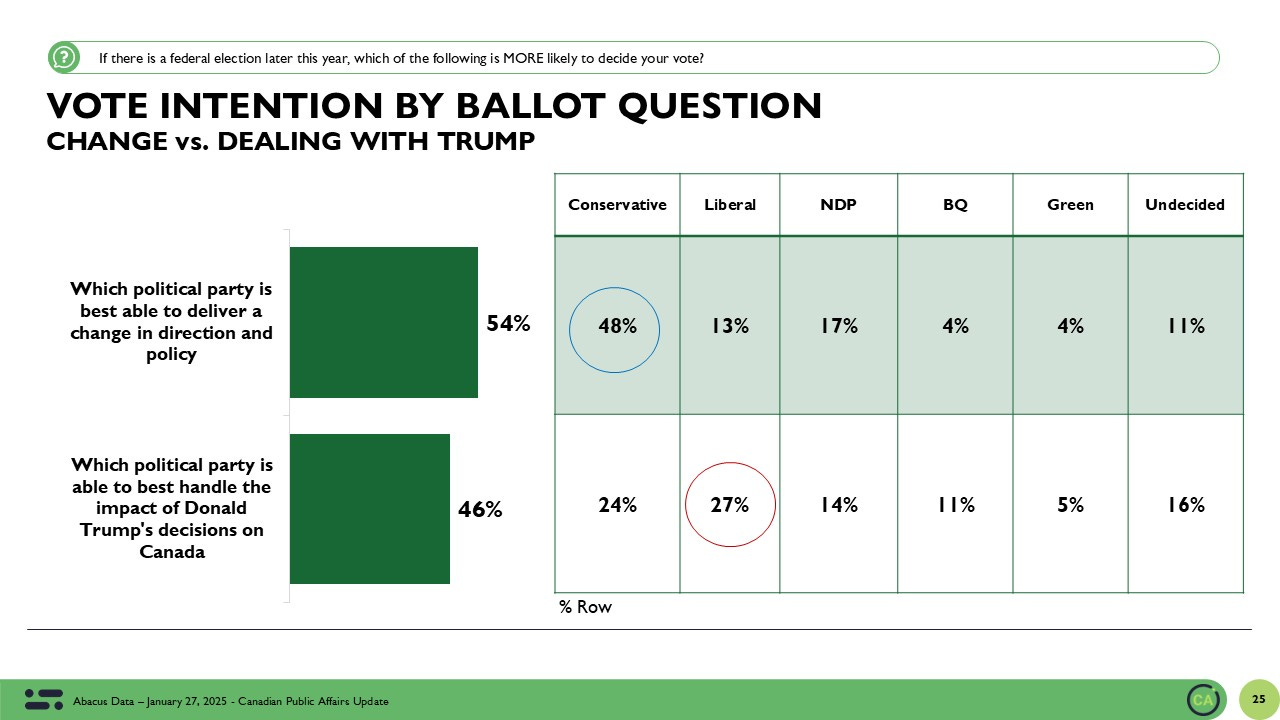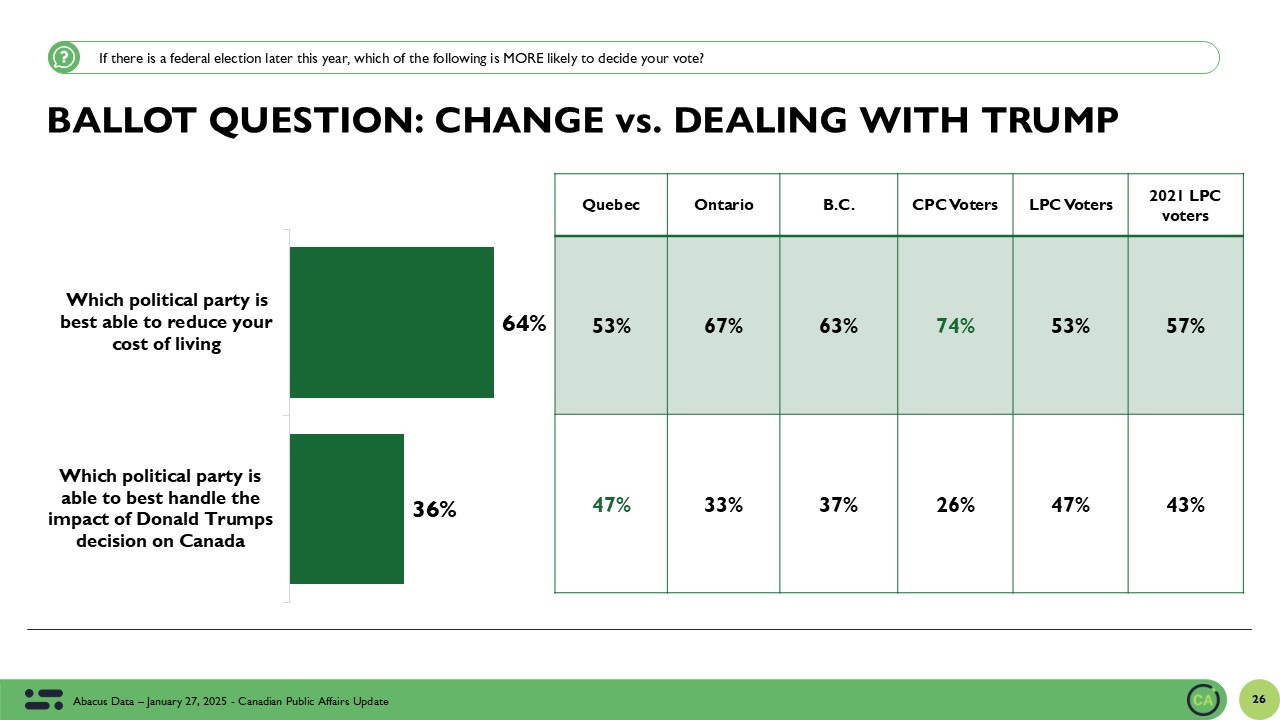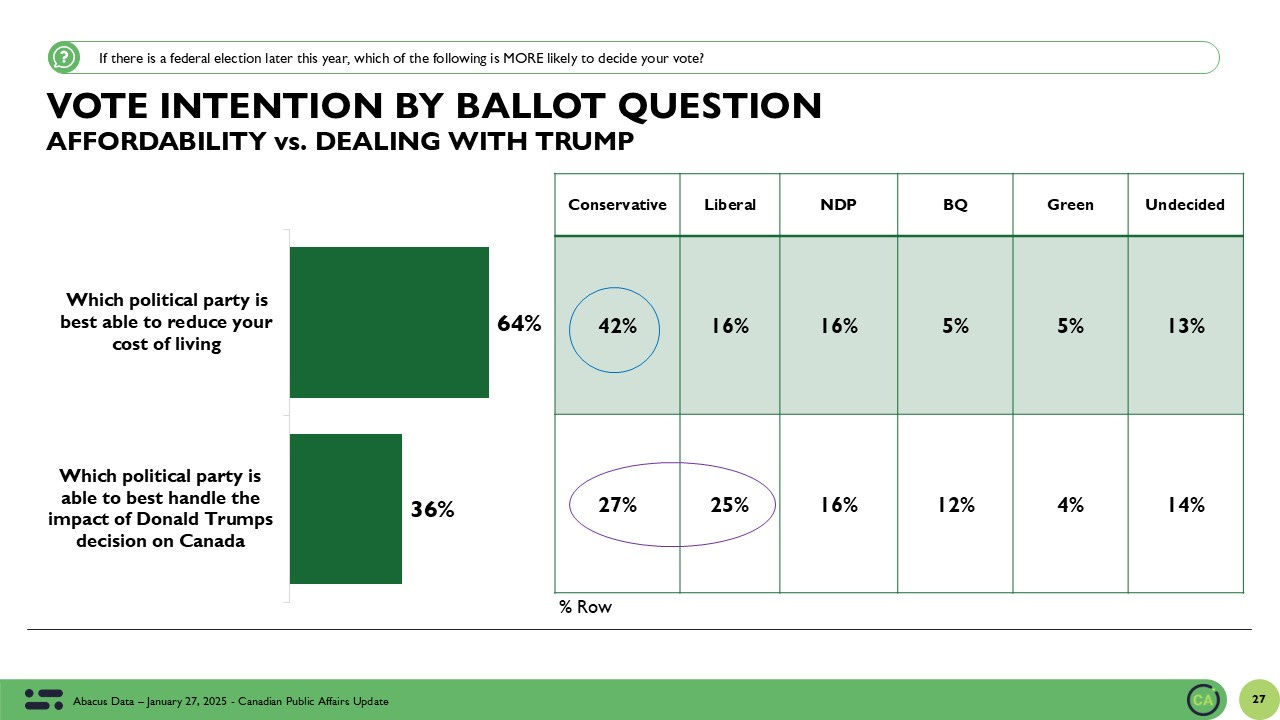What's the ballot question going to be?
How framing the choice for voters can lead to different outcomes.
In my last national Abacus Data survey, I asked some questions I think shine a bright light on the interplay between voters’ economic concerns and their apprehensions about renewed tensions with the Trump administration.
In every election, there’s a question—or set of questions—that emerges as the focal point for many voters as they decide where to cast their ballots. Right now, for a sizeable segment of Canadians, that question centres on affordability and the sense that rising costs of living are eroding their financial security.
Beneath that, however, is a growing anxiety about Trump’s return and the looming possibility that his decisions could leave our economy, labour market, and consumer prices worse than they are perceived to be now. When an electorate begins to recalibrate what frames its mindset, the ballot question can shift, sometimes dramatically. In other words, if Canadians increasingly see the next federal election as being primarily about who can best handle the fallout from a volatile Trump administration—real or perceived—that shift in perspective could upend conventional wisdom about who holds the advantage on the economic file, the national unity file, and overall leadership ability.
Canadians, for the moment, appear most animated by the affordability crunch. Data from our survey reveals that, when asked if they are more likely to base their vote on which party can deliver “a change in direction and policy” versus which party can best handle the impact of Donald Trump’s decisions on Canada, 54% prioritize change and direction, while 46% lean toward Trump-related concerns.
That may not sound like a massive gap, but in an election environment, an eight-point spread can shape the campaign narrative. Voters in Ontario (57%) and British Columbia (55%) tilt more heavily toward wanting change, compared to those in Quebec (37%), who appear more attuned to how Trump’s decisions might affect them. Conservative voters (70%) are far more likely than Liberal voters (36%) to prioritize an election ballot question framed around change and direction—perhaps reflecting a desire to move on from the Trudeau era. Meanwhile, a majority of those who supported the Liberals in 2021 (59%) are significantly more concerned about how to deal with Trump’s policies - although not a sufficient amount to lead to a reconstitution of the 2021 Liberal coalition.
This focus on where the real battle lines lie becomes even clearer when we slice the data by party preference. Among those who say their ballot question is primarily about who can deliver a new direction, nearly half (48%) already indicate a leaning toward the Conservative Party, while only 13% gravitate to the Liberals, 17% to the NDP, and smaller fractions to the BQ or Greens.
By contrast, among those whose top concern is finding a party best able to navigate the aftermath of Donald Trump’s decisions, the Liberals vault into a more competitive position (27%), edging out the Conservatives (24%), and leaving the NDP (14%) well behind. Note in both cases the challenge facing the NDP in a polarized environment around these two frames.
The overall takeaway is that framing matters: if the ballot question during the campaign period is about change and fresh leadership, the Conservative Party seems well-positioned to benefit. If it instead becomes a question of who can stand up to Trump and protect Canadians, the Liberals gain some traction, though it’s not a blowout. Voters are still relatively divided on whether the Liberals, in their post-Trudeau iteration, would really be the best option for dealing with a potentially combative Trump White House. But at least in that frame, the Liberals are not at such a stark disadvantage.
A similar dynamic emerges when we shift the question to cost of living versus Trump’s impact. In that scenario, 64% of Canadians say they’re primarily concerned with which party can best reduce their cost of living, while 36% lean toward which party can best handle the consequences of Trump’s policy decisions for Canada. Regionally, this cost-of-living focus runs high in Ontario (67%) and British Columbia (63%), although even in Quebec (53%), a slight majority still emphasize affordability. The Conservative base is especially fixed on cost-of-living issues: 74% of current CPC supporters say that’s their top priority, while only 26% lean toward Trump’s impact as a deciding factor.
That ratio flips somewhat among Liberal voters, with 53% concerned about affordability and 47% worried about the reverberations of Trump’s policies; similarly, for those who supported the Liberals in 2021, 57% cite cost of living as paramount, with 43% focusing on the Trump factor. This distribution suggests that the Liberal Party’s base, and especially its more recent supporters, remain sensitive to foreign policy dynamics—likely because they remember past trade skirmishes and disruptive tweets that threatened Canada’s auto sector, steel industries, and other key economic drivers.
The cross-tabulation by vote intention under this affordability versus Trump dichotomy is perhaps even more telling. Those who choose “reducing your cost of living” as the main ballot question lean heavily Conservative (42%), with the Liberals at 16% and NDP at 16%. That gives a massive advantage to the Conservatives if the narrative focuses on kitchen-table economics—an advantage that dwarfs their lead in most standard ballot question measurements.
On the other hand, among Canadians who frame the next election around dealing with Trump rather than affordability, the Liberals lead with 25%, while the Conservatives drop to 27%. That near tie—27% for the Conservatives and 25% for the Liberals—highlights how quickly the dynamic can change. Overall, the data underscores that if the public discourse remains squarely on cost of living and affordability, the Conservatives may well reap the benefits. But if the public begins to recalibrate and sees Trump’s tariff and annexation musings as the more critical threat—and if that threat grows salient enough to overshadow bread-and-butter concerns—there could be a real shift in vote intention.
The question, then, is how that shift in emphasis might happen in practice.
Many Canadians distinctly remember the tumult of the previous Trump administration. Even if tariffs and combative rhetoric were not always front-page news in their everyday lives, disruptions to supply chains and the persistent threat of sudden policy reversals caused stress among business owners, farmers, and communities reliant on cross-border trade.
That memory is still relatively fresh, yet the immediate economic pressures—rising interest rates, housing affordability, grocery prices—are even more pressing for a large swath of the population. Voters, as they often do, zero in on the issue that affects them most palpably. Right now, those immediate pressures dominate. But if Trump’s actions, or potential actions, become more concrete—say, through new tariffs on Canadian steel or renewed threats to dismantle key trade agreements—those external factors could swiftly rise to the top of Canadians’ hierarchy of concerns.
Once that happens, the question of whether the next prime minister can effectively shield the country from White House unpredictability might eclipse short-term concerns about inflation and interest rates. In that scenario, the Liberals (or whichever party can present a coherent plan to manage U.S. turbulence) might become the de facto “safe pair of hands” in the eyes of a majority of voters.
At this crossroads, the looming departure of Justin Trudeau from the Prime Minister’s Office adds another layer of complexity. Trudeau’s brand has long been tied to a fluid worldview. With Trudeau exiting the political stage, the question becomes whether Mark Carney, Karina Gould, Chrystia Freeland, or another Liberal contender can credibly claim the mantle of “steady hand on global affairs” and “protecting Canadians from the impact of Trump” especially if voters are uncertain about their ability to steer Canada through the swirl of international turmoil.
Meanwhile, Conservative leader Pierre Poilievre, whose brand is more domestically oriented (focusing sharply on inflation, taxes, and economic rejuvenation), has not yet been fully tested on the global stage. In a campaign framed around who can keep the White House in check, the Conservatives might find themselves challenged by questions of experience or diplomatic acumen, though they could attempt to pivot by arguing that their own pragmatic, results-driven approach would yield better outcomes in any potential face-off with a new Trump administration.
Another crucial factor is whether the media and public debate will elevate the Trump storyline enough to make it a genuine ballot question.
Right now, Canadians are bombarded by headlines about housing affordability, record food prices, and tough financial decisions many families are making daily. The cut in the interest rate this week will help, but also signals the possibility of rising concern about employment security.
The cost-of-living theme resonates because it’s so immediately tangible: you see it at the gas station, at the grocery store, on your credit card statement. Trump’s impact, by contrast, can feel somewhat more abstract—at least until it directly affects industries, jobs, or supply lines. In focus groups, we often hear participants say they believe the state of Canada’s relationship with the U.S. is extremely important, yet they confess that it’s not the first thing they think about when paying the bills at the end of the month. That dynamic can change rapidly, but it requires a triggering event or a sustained pattern of disruptive behavior from Washington that captures the public’s attention and imagination.
In the 2019 federal election, the spectre of Trump was present, but it never dominated the discourse. Many voters believed the United States-Mexico-Canada Agreement (USMCA) showdown had been resolved enough that immediate existential threats were off the table. Instead, the conversation in that campaign cycle quickly turned to ethics, climate, and other domestic issues.
If Trump’s second act in U.S. politics proves more aggressive—if new threats or policies aim squarely at Canadian trade or security—then the story may well unfold differently this time. This new data suggests that once Canadians view the next election as a referendum on dealing with Trump, the Liberals find a second wind among crucial segments of the electorate, particularly those who are either on the fence or who voted Liberal in the past. Still, an effective Conservative counter-narrative could neutralize that advantage if they frame the Liberals’ approach as naive or ineffective, especially if they can tie the Liberals to past trade missteps or the sense that Trudeau-era policies hurt Canada’s negotiating position.
In all of this, the leadership question remains paramount. Voters across the country consistently tell us in surveys and focus groups that they want to see a prime minister with a clear command of the economic dossier who can also hold his or her own on the global stage.
Many Canadians remain unsure whether the next Liberal leader—be it Freeland, Gould, Carney, or another figure—will maintain Trudeau’s style of public engagement, or pivot to a different approach that might reassure Canadians that the government can handle both local and international uncertainties.
When we ask Canadians to name who they trust more on the economy, the Conservatives often come out ahead, a gap that has widened in the last year as affordability concerns have grown. When we ask specifically about handling foreign leaders, the picture becomes more nuanced, with many respondents acknowledging that while they might prefer a more pragmatic approach, they are still unconvinced that any one party truly has the upper hand in dealing with a mercurial figure like Trump - although Poilievre consistently bested Trudeau on that specific measure.
This suggests that whoever hopes to win the next election will need to demonstrate competence on both fronts, or at least convince voters that their team has the skill set to manage whatever the world throws Canada’s way.
The interplay between these two frames—pocketbook issues at home and unpredictable challenges abroad—is not new, but our current data highlights how finely balanced they can be. In one version of the ballot question, the Conservatives run away with the narrative by hammering on everyday affordability and a promised break from Liberal economic policies. In another version, one triggered by escalating tensions or disruptive moves from the U.S., the Liberals can refocus the public’s attention on who is best equipped to protect Canadian interests on the world stage.
Both stories have traction. Both connect to deeply held voter concerns. The deciding factor in which story gets told will likely be events on the ground—whether affordability remains the primary focus of voters, whether Trump’s rhetoric or policy escalate and directly threaten Canada’s interests, and whether the next Liberal leader can pivot effectively to harness Canadians’ anxiety about returning to a perpetual trade war with our biggest trading partner.
For now, the data shows that 54% of Canadians say they’re leaning toward wanting the next election to be about delivering fundamental change in direction, while 46% say they want it to be about managing Trump’s impact. That single snapshot reveals a near-even split that, in practical terms, suggests a campaign could break either way depending on who defines the terms of debate. The same pattern appears with the cost-of-living question versus Trump’s decisions. While 64% put affordability first and only 36% put Trump first, that 36% can still prove pivotal, especially if any external developments create a groundswell of coverage and concern over trade or foreign policy.
Voters often shift their emphasis when a crisis arrives. If you had asked Canadians in 2018 about the number-one election issue, many might not have said the USMCA negotiations until it appeared that U.S. tariffs were about to devastate certain sectors. Likewise, Canadians’ priorities can change on a dime if the context shifts. Currently, the immediate pinch of inflation and other domestic economic challenges remains top-of-mind, but in the next six to twelve months, events outside our borders may intrude more forcefully into everyday life, prompting a reevaluation of the ballot question.
Tracking how these frames evolve over time is precisely what we intend to do. As the political landscape shifts and as Canada moves closer to an election in a post-Trudeau environment, we will continue to ask Canadians which issues they see as most relevant to their voting decision.
We will examine how events—such as any new announcements or threats from a Trump-led movement in the United States—change people’s sense of what is at stake. And we will look at how vote intentions shift as that perception of the ballot question shifts. If voters come to believe that the pressing question is, “Who can reduce my cost of living right now?” the data suggests the Conservatives hold a notable advantage. If, however, the conversation widens to, “Who can protect Canadians and from a resurgent Trump presidency?” then the Liberals (under new leadership) have a window of opportunity to reposition themselves as the better protectors of Canadians (Doug Ford will show us whether that framing is effective). I’ll continue to monitor these dynamics, capturing how swiftly voter concerns can move from one sphere to the other, and what that movement might signal for party support and electoral outcomes. I’ll report back what we see.





